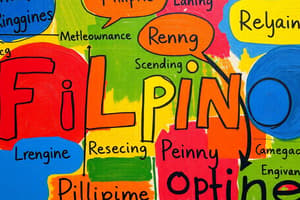Podcast
Questions and Answers
Alin sa mga sumusunod ang pinakaangkop na paglalarawan sa konsepto ng 'register' bilang isang barayti ng wika?
Alin sa mga sumusunod ang pinakaangkop na paglalarawan sa konsepto ng 'register' bilang isang barayti ng wika?
- Ang paggamit ng wika batay sa edad ng isang nagsasalita.
- Ang paggamit ng wika batay sa pinagmulang rehiyon ng isang tao.
- Ang paggamit ng wika batay sa sitwasyon, layunin, at kausap. (correct)
- Ang paggamit ng wika batay sa pormalidad ng lugar kung saan ito ginagamit.
Sa konteksto ng pag-aaral ng wika, paano naiiba ang 'idyolek' sa 'dayalek'?
Sa konteksto ng pag-aaral ng wika, paano naiiba ang 'idyolek' sa 'dayalek'?
- Ang idyolek ay personal na gamit ng wika, samantalang ang dayalek ay kolektibong wika ng isang komunidad. (correct)
- Ang idyolek at dayalek ay parehong tumutukoy sa kolektibong wika, ngunit ang dayalek ay mas malawak.
- Ang idyolek at dayalek ay parehong tumutukoy sa personal na gamit ng wika, ngunit ang idyolek ay mas pormal.
- Ang idyolek ay kolektibong wika ng isang komunidad, samantalang ang dayalek ay personal na gamit ng wika.
Alin sa mga sumusunod ang nagpapakita ng kahalagahan ng pag-aaral ng barayti ng wika sa lipunan?
Alin sa mga sumusunod ang nagpapakita ng kahalagahan ng pag-aaral ng barayti ng wika sa lipunan?
- Nakakatulong ito upang maunawaan ang pagkakaiba-iba ng wika at kultura sa lipunan. (correct)
- Nagbibigay-daan ito upang masuri ang gramatika ng iba't ibang wika.
- Nagpapalawak lamang ito ng bokabularyo ng isang tao.
- Nakakatulong ito upang maging eksperto sa lahat ng wika.
Kung ang isang bata ay lumaki sa isang tahanan kung saan Filipino at Ingles ang madalas gamitin, anong konsepto ng pagkatuto ng wika ang inilalarawan nito?
Kung ang isang bata ay lumaki sa isang tahanan kung saan Filipino at Ingles ang madalas gamitin, anong konsepto ng pagkatuto ng wika ang inilalarawan nito?
Sa konteksto ng kasaysayan ng Wikang Pambansa, ano ang naging papel ng Konstitusyon ng Biak-na-Bato?
Sa konteksto ng kasaysayan ng Wikang Pambansa, ano ang naging papel ng Konstitusyon ng Biak-na-Bato?
Paano naiiba ang pidgin sa creole bilang barayti ng wika?
Paano naiiba ang pidgin sa creole bilang barayti ng wika?
Sa ilalim ng K to 12 Kurikulum, anong pagbabago sa pagtuturo ng wika ang ipinatupad?
Sa ilalim ng K to 12 Kurikulum, anong pagbabago sa pagtuturo ng wika ang ipinatupad?
Ayon kay M.A.K. Halliday, alin sa mga sumusunod ang naglalarawan sa tungkuling 'regulatoryo' ng wika?
Ayon kay M.A.K. Halliday, alin sa mga sumusunod ang naglalarawan sa tungkuling 'regulatoryo' ng wika?
Alin sa mga sumusunod na sitwasyon ang pinakamahusay na nagpapakita ng gamit ng wika bilang 'instrumental' ayon sa kategorya ni M.A.K. Halliday?
Alin sa mga sumusunod na sitwasyon ang pinakamahusay na nagpapakita ng gamit ng wika bilang 'instrumental' ayon sa kategorya ni M.A.K. Halliday?
Ano ang pangunahing layunin ng MTB-MLE (Mother Tongue-Based Multilingual Education) sa Pilipinas?
Ano ang pangunahing layunin ng MTB-MLE (Mother Tongue-Based Multilingual Education) sa Pilipinas?
Flashcards
Ano ang wika?
Ano ang wika?
Mahalagang kasangkapan sa pagpapahayag ng kaisipan at damdamin na binubuo ng makabuluhang tunog, simbolo, at tuntunin.
Wikang Pambansa
Wikang Pambansa
Ang wikang dapat mauunawaan ng nakararami upang magkaisa ang mga Pilipino.
Wikang Opisyal
Wikang Opisyal
Ang mga opisyal na wika sa Pilipinas ay Filipino at Ingles.
Unang Wika
Unang Wika
Signup and view all the flashcards
Pangalawang Wika
Pangalawang Wika
Signup and view all the flashcards
Monolinggualismo
Monolinggualismo
Signup and view all the flashcards
Bilinggualismo
Bilinggualismo
Signup and view all the flashcards
Barayti ng Wika
Barayti ng Wika
Signup and view all the flashcards
Dayalek
Dayalek
Signup and view all the flashcards
Idyolek
Idyolek
Signup and view all the flashcards
Study Notes
Language Concepts
- Language serves as a vital instrument for communication, facilitating the expression of thoughts and feelings
- Language is composed of meaningful sounds, symbols, and rules
Word origin
- The word "wika" originates from the Latin term "lingua," meaning "tongue."
- It evolved into "langue" in French and "language" in English
Language Definitions
- Paz, Hernandez, and Peneyra (2003) define language as a bridge for expressing needs
- Henry Allan Gleason, Jr. describes it as a systematic arrangement of sounds
- The Cambridge Dictionary defines it as a communication system involving sounds, words, and grammar
National Language
- The Philippines has a rich diversity of languages and dialects
- A common language is essential for unity among Filipinos
History of National Language Selection
- The selection of a national language was intensely debated during the constitutional convention of 1934
- Lope K. Santos proposed basing the national language on an existing native language
Amendment to the Basic Law
- The 1987 Constitution stipulates that Filipino is the national language of the Philippines
- Former President Corazon Aquino supported the use of Filipino in government
Official Language and Language of Instruction
- According to the 1987 Constitution, the official languages are Filipino and English
- Regional languages serve as auxiliary official languages
Language of Instruction
- The K to 12 Curriculum designates "Mother Tongue" as the official language of instruction from Kindergarten to Grade 3
- MTB-MLE (Mother Tongue-Based Multilingual Education) is implemented to improve learning outcomes
First Language, Second Language, and More
- First language is the language learned from birth
- Second language is acquired through exposure to the environment
- Third language refers to additional languages learned while growing up
Monolingualism, Bilingualism, and Multilingualism
Monolingualism
- It involves using only one language in a country (e.g., England, France)
Bilingualism
- It involves the use of two languages as if they were native
- Bloomfield and Macnamara offer various definitions
Multilingualism
- The Philippines is a multilingual country with over 180 languages
- MTB-MLE aims to promote multilingual education
Language Variations
Definition of Language Variation
- Language variation refers to differences in language that arise from interactions among people from diverse places and cultures
- The existence of variation is inevitable and results from the experiences and environments of speakers
Examples of Language Variation
Dialect
- It refers to the variation of language used by a particular group from a specific place
- Examples include Tagalog in Morong, Tagalog in Manila, and Tagalog in Visayas
- Dialects may differ in tone, vocabulary, and sentence structure, but speakers can still understand each other
Idyolek
- It is an individual's unique way of speaking, even if they use the same dialect
- It reflects the speaker's distinct characteristics
- Examples include the unique style of Marc Logan and the "pabebeng" idyolek of Pabebe Girls
Sosyolek
- It is language variation based on people's social status or level
- Examples include the language of educated versus uneducated individuals, and "gay lingo."
- Sosyolek reflects social stratification and may contain jargon from various professions
Pidgin and Creole
- Pidgin is a new language that emerges from the interaction of people with different first languages
- Creole is a pidgin that becomes the first language of a community after prolonged use
Register
- It refers to the appropriate use of language based on the situation and the person being addressed
- Formal language is used in formal occasions, while informal language is used with friends and close acquaintances
Importance of Studying Language Variation
- Studying language variation is essential to understand the differences in language within society
- It helps broaden knowledge about the culture and traditions of different groups
- It emphasizes the importance of communication and understanding among people from different walks of life
Uses of Language in Society
Essence of Language
- Language is a social tool
- Example: The story of Tarzan and his learning of animal sounds
- The significance of interaction in language acquisition is important
Importance of Connection
- People learn language through interaction
- A person without interaction with the community may have difficulty learning to speak
Categories of Language Functions (M.A.K. Halliday)
Instrumental
- Responds to people's need for interaction
- Example: Business letters, advertisements
Regulatory
- Controls the behavior of others
- Example: Directions, cooking steps, instructions
Interactional
- Communication and interaction with others
- Example: Joking, storytelling
Personal
- Expression of opinion and feelings
- Example: Writing a diary
Heuristic
- Seeking information
- Example: Interviewing, reading books
Informative
- Providing information
- Example: Writing a term paper, report
History of the National Language
Period of the Natives
- Negrito, the first to migrate to the Philippines from Borneo and resided in the mountains and forests of Bataan, Zambales, and Northern Luzon
- Indones came from Southeast Asia with greater civilization than the Negrito and resided in Luzon and Mindanao, including the Ibanag, Kalinga, and Apayao
- Malays arrived on boats and many remained pagan while others became Mohamedan, with their own languages derived from Austronesian
Spanish Period
- The goal was to instill Christianity in the natives and divide the islands and communities for more effective governance
- Missionary friars (Augustinians, Franciscans, Dominicans, Jesuits, Recollects) wrote dictionaries and grammar books for the natives
- The use of native languages in trade was suppressed
Period of the Philippine Revolution
- Nationalism sparked after 300 years of colonization
- The use of Tagalog in the newspapers and decrees of the Katipunan became more widespread
- The Constitution of Biak-na-Bato declared Tagalog as the official language
American Period
- English was introduced as the language of instruction
- Act No. 74 established public schools
- Vernacular instruction recommended the use of vernacular as an auxiliary language
Japanese Period
- Promotion of the National Language
- English was banned and the use of Tagalog was strengthened
- Military Ordinance No. 13 declared Tagalog and Japanese as official languages
Period of Independence to the Present
- Commonwealth Act No. 570 declared Tagalog and English as official languages
- Department Order No. 7 (1959) replaced the term for the national language from Tagalog to Filipino
- The 1987 Constitution declared Filipino as the national language, with Article XIV, Section 6 promoting the enrichment of existing languages in the Philippines
Challenges and Progress
- Present situation shows the continued progress of the Filipino language despite challenges
- Executive Order No. 210 brought back monolingual teaching in English
Studying That Suits You
Use AI to generate personalized quizzes and flashcards to suit your learning preferences.




